Canada celebrated its 150th birthday last year. At the same time, Montreal was celebrating its 375th. The city was founded in 1642 at Pointe-à-Callière, the meeting point of the Saint-Pierre and Saint Lawrence Rivers. This confluence of opposites resonates throughout the entire city: it’s old but filled with fresh ideas and innovation, it’s French and it’s English, it’s Old World and New. When they come together, they create one of the most interesting cities in the world.
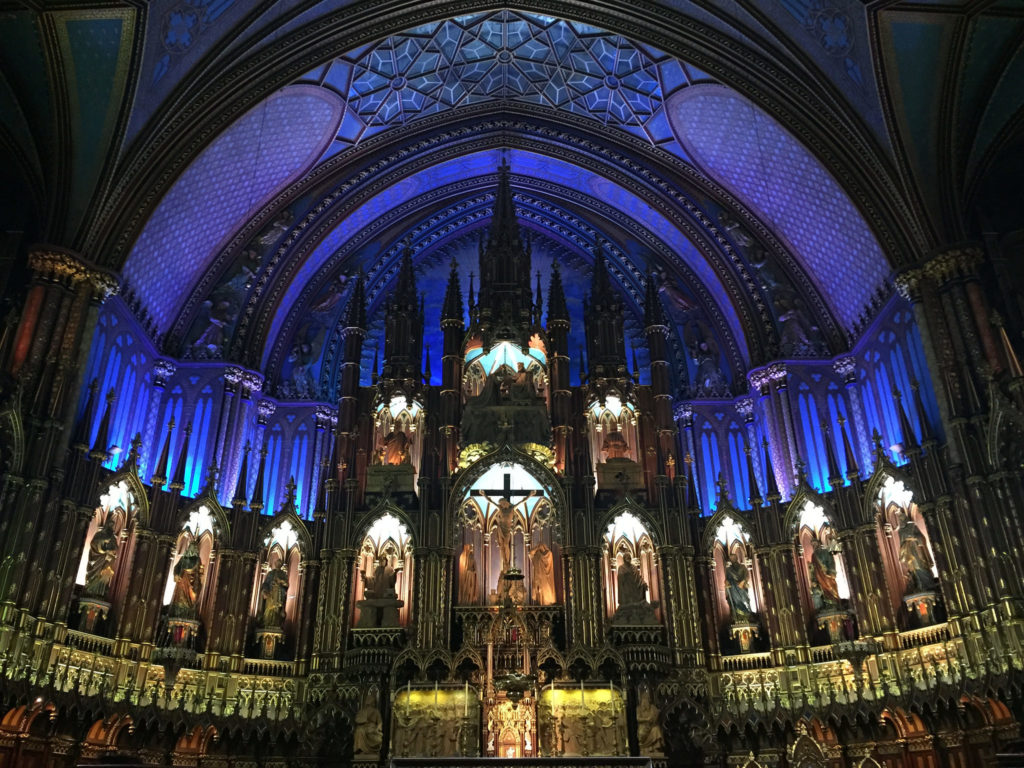
Inside Notre Dame Basilica (Photo: Shelby L. Bell via Flickr)
The historic shops, museums, and port area are the biggest draws to Old Montreal for visitors and locals. Whether it’s walking or cycling along the boardwalk, learning something new, or a relaxing at the spa, Old Montreal is undoubtedly the city’s most romantic district. The cobblestone streets and early architecture usually lead people to the Place d’Armes, one of the most beautiful public squares in Montreal. It’s the perfect spot for admiring the eight-storey New York Life building, Montreal’s first skyscraper (1888), and the famous Notre-Dame Basilica (110 Notre-Dame St W).
The gilded Gothic Revival basilica was built in 1829 and stands as one of Montreal’s most important landmarks in Quebec’s religious heritage. Once inside, you’ll see beautifully carved wood framing a magnificent Casavant organ and unique stained-glass windows that depict the city’s religious history. The Basilica made international headlines when former U.S. President Jimmy Carter and Fidel Castro served as pall-bearers at the funeral of former Canadian Prime Minister Pierre Trudeau in 2000.
Just around the corner is the narrow Rue Saint-Paul, the old main street that takes its explorers right back to the 17th century. The cobblestone street is filled with independent shops, quaint restaurants, and remarkable art galleries featuring the work of Canada’s talented artists. Follow the road past Place Jacques-Cartier, a lovely square with a view of the splendid 1870s Second Empire-style City Hall, to Bonsecours Market (350 St Paul St E).
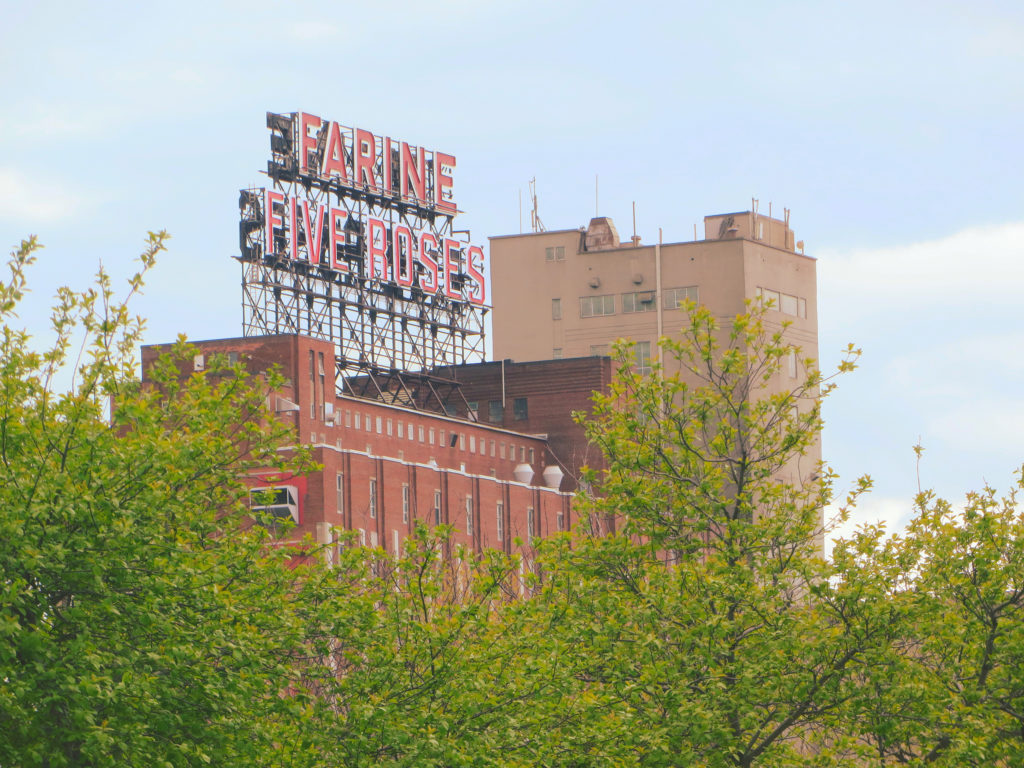
Historic Five Roses Factory sign (Photo: Alyssa James)
Throughout its 170-year history, Bonsecours was the city’s main public market. While you won’t find apples and wheat hauled in on horse-drawn carriages anymore, the market is still an important part of Montreal’s cultural tapestry. It houses 15 boutiques featuring the best ‘Made in Quebec’ creations, including clothing, jewellery, and confections. Restaurants and cafes have beautiful terraces overlooking the Old Port.
Just to the east is Vieux-Port, the Old Port of Montreal. The historic harbour was used as a trading post for French fur traders in the 17th century. It was also the easterly destination for Canada’s first transcontinental railway in 1881 and a major arrival port for Caribbean bananas in the early 20th century. Today, the Old Port doesn’t act as a commercial harbour, but offers a waterfront recreation area with shops, museums, a beach under the Beaux-arts-style clock tower, and the home of the Canadian Cirque du Soleil company. If an urban beach isn’t your thing, there are two spas: the indoor Scandinave Spa (71 de la Commune St W) offers traditional Scandinavian hydrotherapy while high-end Bota Bota, spa-sur-l’eau (Corner of Rue de la Commune and Rue McGill) floating spa on a converted ferry boat offers diverse treatments, outdoor pools, yoga, and a restaurant.
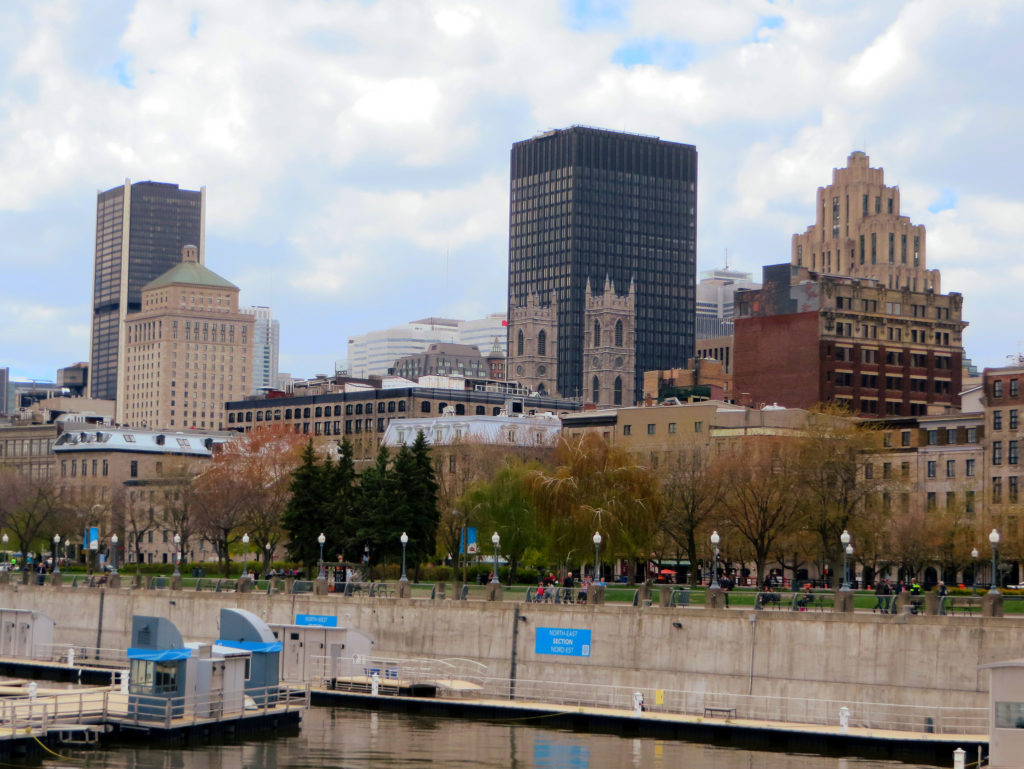
View of Old Montreal from the Port (Photo: Alyssa James)
Old Montreal is fittingly the home of most of Montreal’s historical museums. The Pointe-à-Callière Museum (350 Place Royale) is the city’s museum of archaeology and history. The museum stands on the site where Montreal’s first building was erected–back when the city was called Ville-Marie. Inside, you’ll find the products of archaeological digs and interactive exhibits. Most visitors start with the Yours Truly, Montreal multimedia show, which covers the history of the Montreal through to the present day on a journey through the centuries.
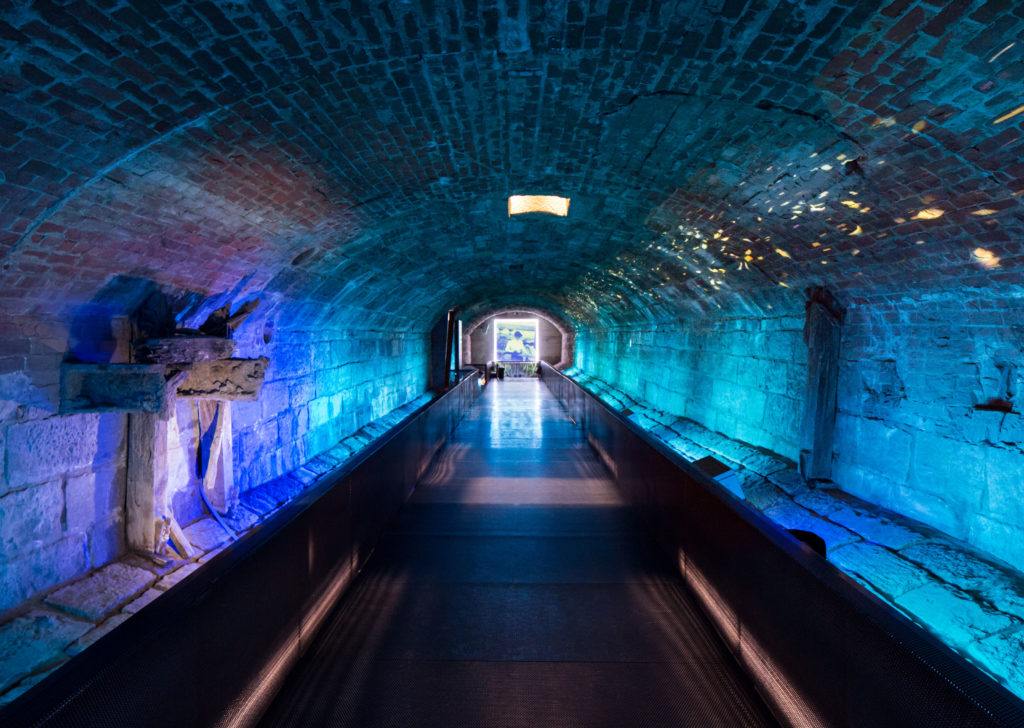
First collector sewer in North America at Pointe-à-Callière (Photo: Stéphane Brügger)
A former fire station now houses the Centre d’histoire de Montreal (335 Place d’Youville), a museum that tells the story of Montreal and its people through a variety of permanent and temporary exhibitions. Other cultural institutions in the area include the Montreal Science Centre (2 de la Commune St W), filled with imaginative science and technology exhibits, while the Phi Centre (407 Rue Saint-Pierre) is a venue that features events, exhibitions, performances, and institutions that challenge and innovate in the digital age. Their permanent Virtual Reality Garden installation makes it Montreal’s premier destination for VR experiences.
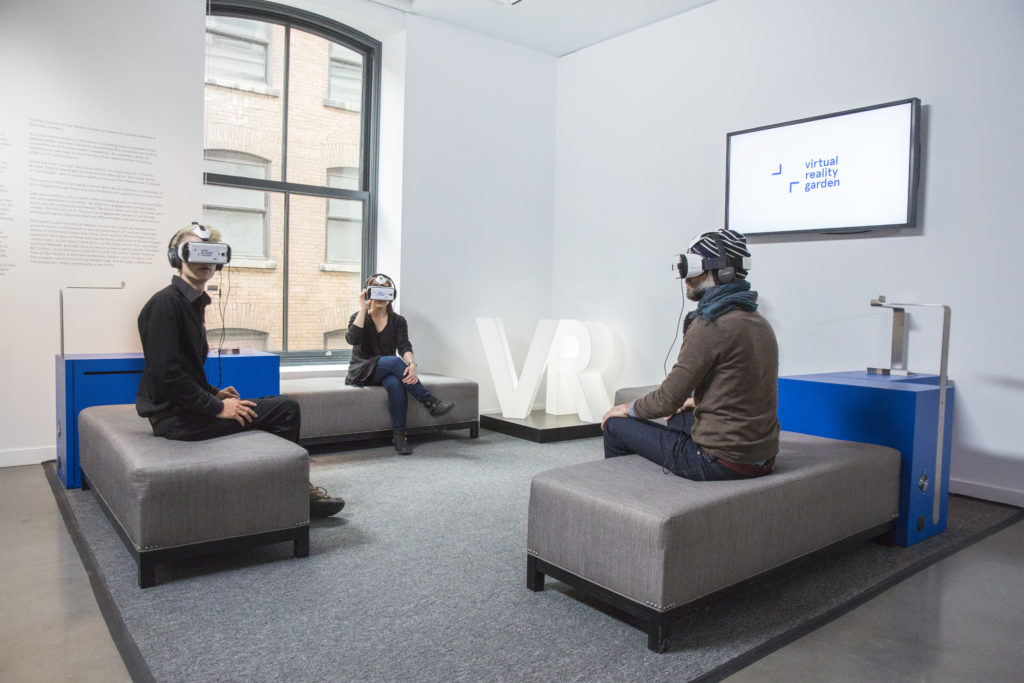
Virtual Reality Garden (Photo: Phi Centre)
Hotels in Old Montreal
The range of hotels in Old Montreal cover budget bed and breakfasts to hip boutique hotels and elegant luxury establishments. Hotel Place d’Armes (55 Rue Saint-Jacques Ouest) is the standout choice in Old Montreal thanks to its sumptuous comforts and excellent location a few minutes walk from the main Old Montreal metro station. The hotel is housed in a 19th-century Neoclassical building, just opposite the Notre-Dame Basilica. Take a seat and unwind at the hotel’s popular rooftop bar overlooking Old Montreal or enjoy the 3000-square foot full-service Rainspa for ultimate relaxation and rejuvenation.
For rooms filled with Old World charm, travellers choose the Auberge du Vieux-Port (97 de la Commune St E), the hotel settled on the banks of the scenic St Lawrence river. The rooms feature period details like exposed brick, wrought iron beds, and the original casement windows that allow you a view of the river or cobblestone streets of Rue Saint Paul.
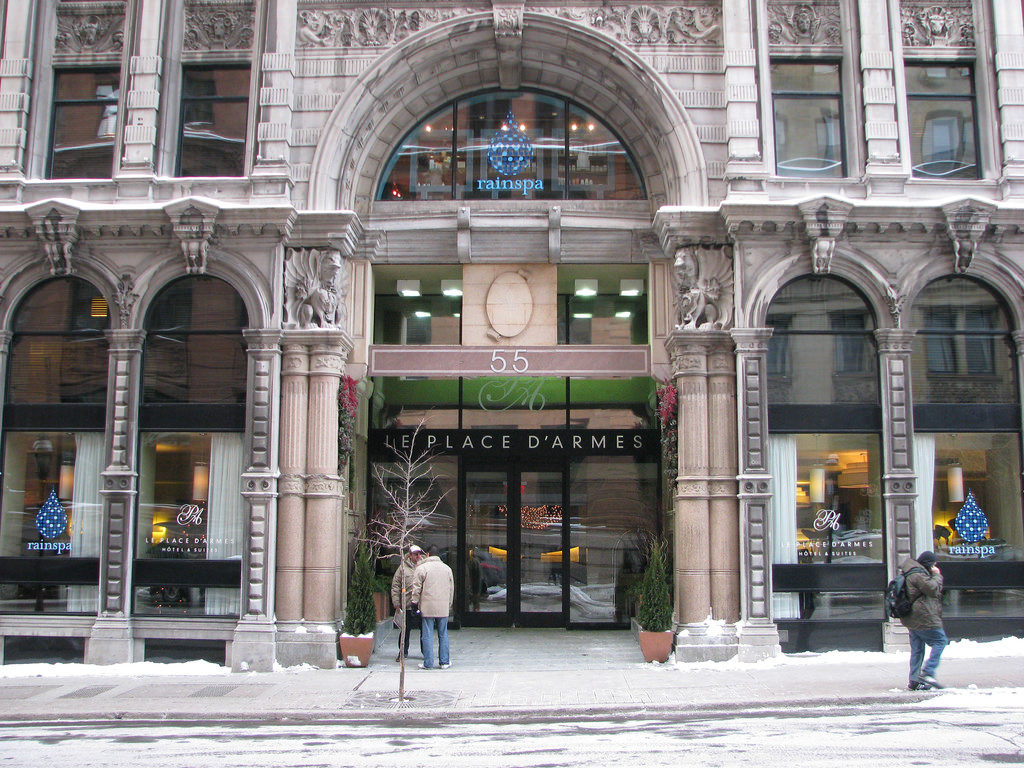
Hotel Place d’Armes in winter (Photo: sookie via Flickr)
Hotel Nelligan (106 Saint-Paul St W)—named for Quebecois poet Émile Nelligan—is boutique luxury with modern rooms, 24-hour concierge service, and contemporary cuisine at Verses Restaurant. The attention to detail and personalized touches prompted Condé Nast to name Hotel Nelligan 3rd in Canada and 1st in Montreal.
The more budget conscious traveller might choose the twelve-room Auberge de la Place Royale (115 de la Commune St W), a homey inn with an enviable address on Rue de la Commune Ouest. Suites are cozy and comfortable in a beautiful building with a river view. It’s the perfect place for guests who want to be completely independent in the heart of Old Montreal.
Eat and Drink
The cozy Olive & Gourmando (351 Saint-Paul St W) is a great place to start your day. The café-slash-bakery serves up delicious breakfast items, from healthy chia puddings to gourmet French toast and flaky pastries. You can’t go wrong at lunch either with scrumptious paninis, rich mac + cheese, and hearty salads. For something a bit different head to the Crew Collective & Café (360 St Jacques St), housed in the 1928 original headquarters of the Royal Bank of Canada with original brass light fixtures and inlay marble floors, is a beautiful café and workspace. The coffee is excellent and brunch is a winner, particularly the fresh juices, and grapefruit and goat’s cheese tartine — all of which can be ordered online.
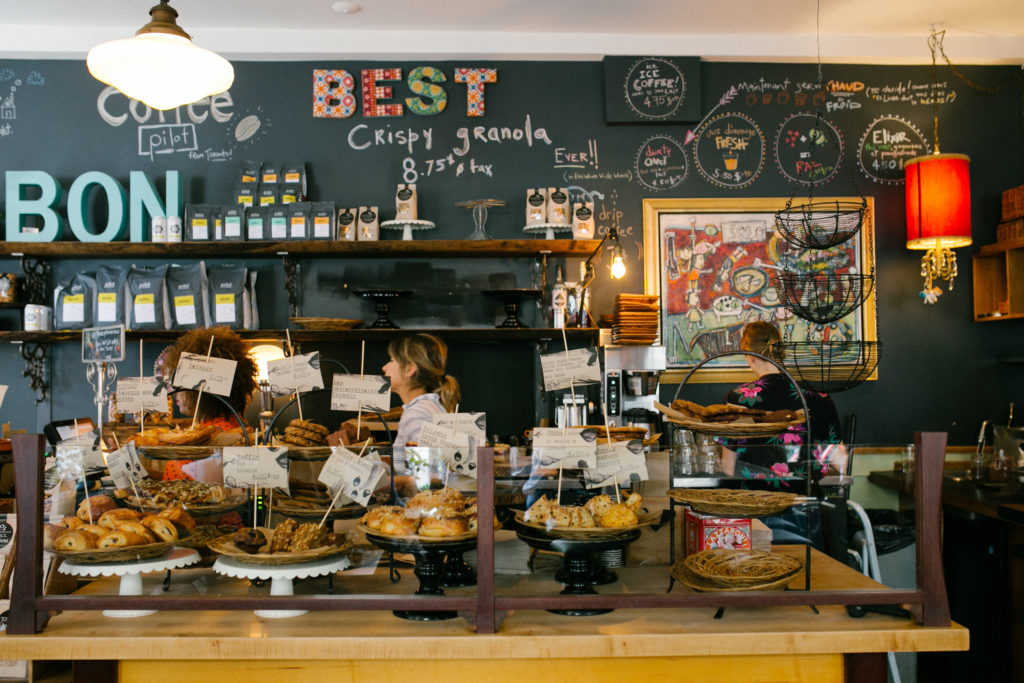
Quite the breakfast selection at Olive + Gourmando (Photo: Michaël Bandassa)
Vegans and carnivores alike will love LOV (464 McGill St)—local, organic, and vegetarian—a restaurant that boasts a fantastic range of vegan and vegetarian dishes with global influences including the banh mi burger and gnocchi. The whimsical décor is natural and minimalist, with private and communal tables, as well as a few hanging chairs in the back. At brunch, enjoy the full Lumberjack breakfast or the moreish waffles; for dinner, specialities like kimchi fries, vegan poutine, and a smoked beet sandwich (after smoked meat, Montreal’s local speciality).

Minimalist interiors at LOV in Old Montreal (Photo: Patricia Brochu)
If there’s one place that should not be missed, it’s Toqué! (900 Jean Paul Riopelle Pl), the innovative restaurant topping the list of the best restaurants in Canada. Chef Normand Laprise, the only Canadian chef to sit on the International Chefs Advisory Board in Lyon, France, is constantly pushing boundaries with visionary recipes using locally sourced products. The 7-course tasting menu with wine pairings offers the quintessential tastes of Quebec—it’s truly incontournable.
Independent Shops
Montreal is home to a high proportion of people working in creative industries; people in this city love to express themselves. Fashion, accessories, art, and design are just some of the ways people do that in Montreal, making it an premier city for a bit of retail therapy. Open your eyes and your style with a stop at Le Bar à Lunettes (401 McGill St), a boutique that sells funky glasses of the sun and prescription variety.
Cahier d’Exercices (369 Saint-Paul St W) is the ultimate destination for anyone who wants curated fashion designs. Each piece is hand-picked by the owner from international runways, so you’ll find avant-garde designs created by global talent. Every piece is displayed with care, making Cahier d’Exercices more like an art gallery than a clothing store.
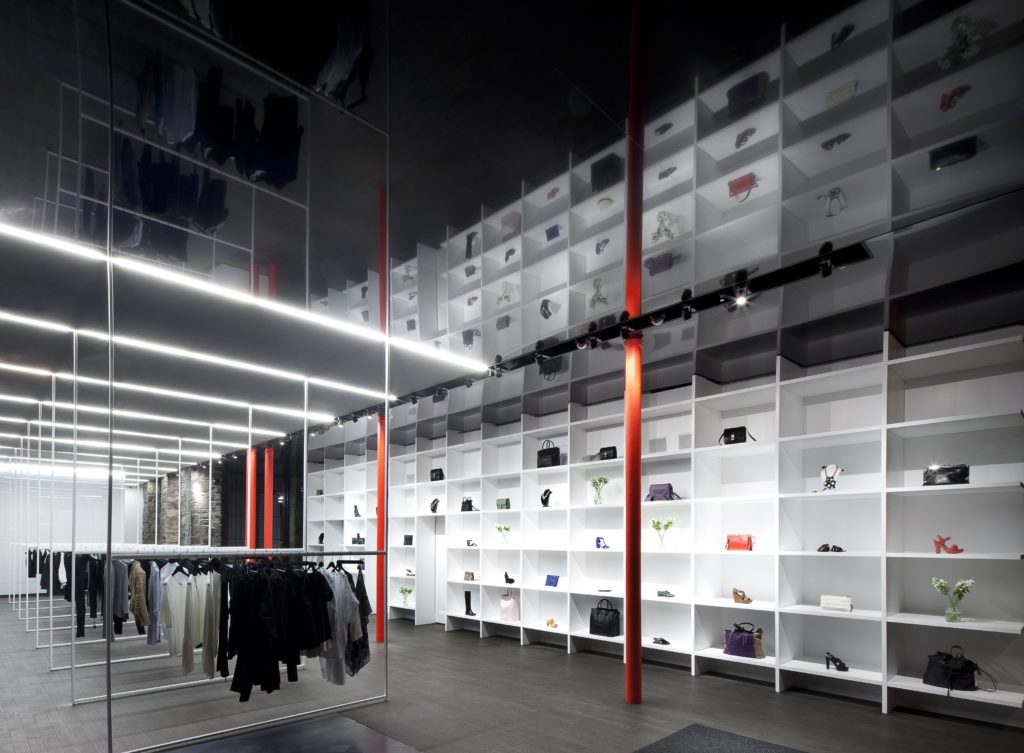
High-end women’s clothing at Cahier d’exercices (Photo: Marc Cramer)
For vintage fashion and homeware, Le Magasin Général du Vieux-Montréal ( 3 de la Commune St E) concept store is the place to go. You’ll find a large selection of decorative items, vintage and contemporary, in the most creative styles. An eclectic selection of handbags, wallets, sunglasses, jewellery, and more are also on the floor. It’s the perfect boutique to keep your home and your style original and unique. The shop also houses a bistro that serves lunch, brunch, and cocktails.